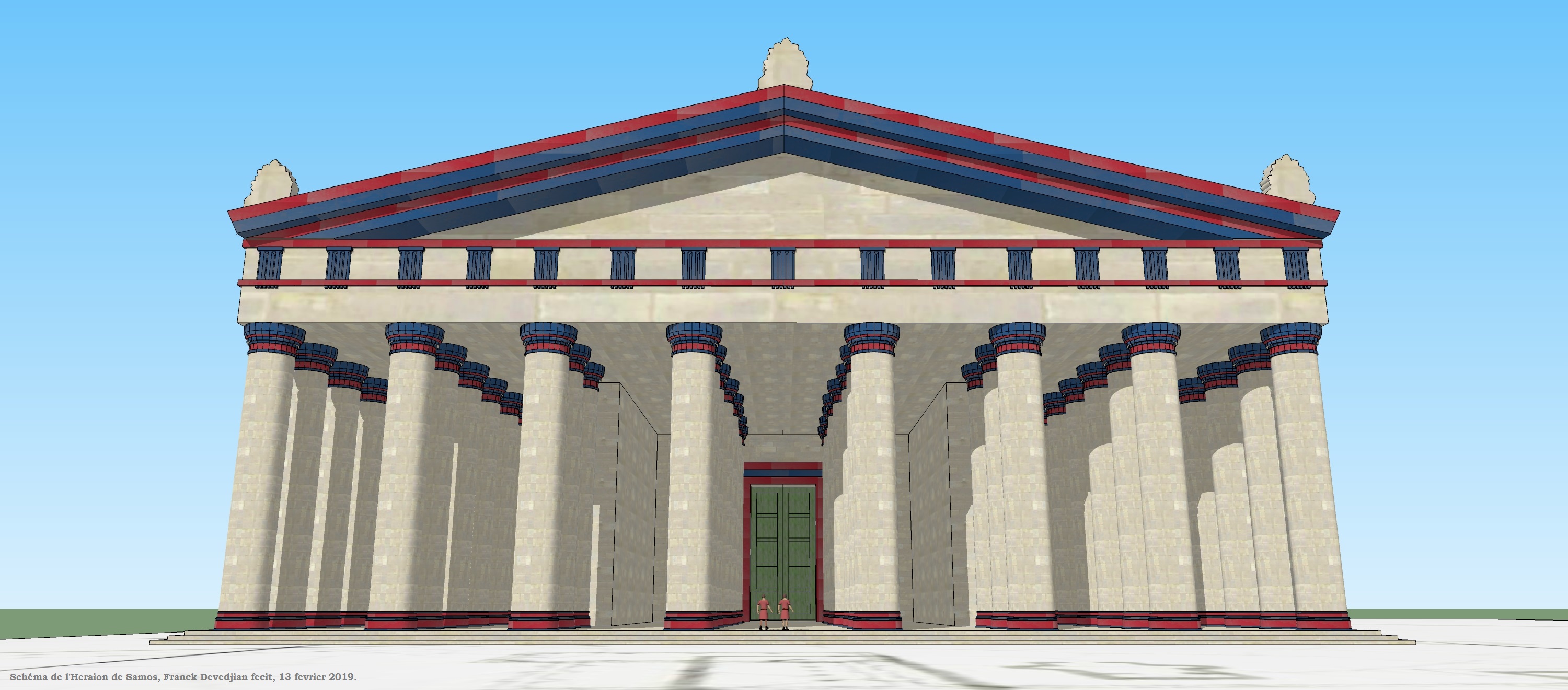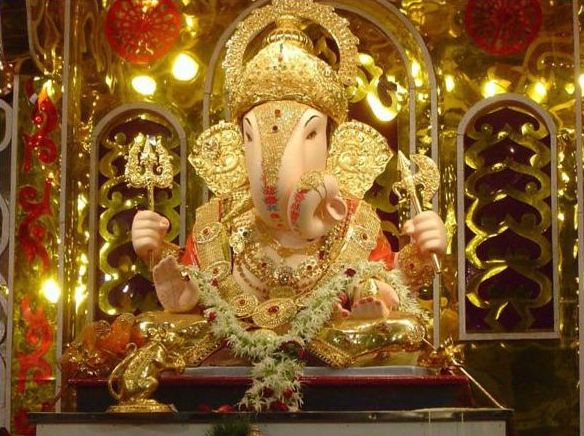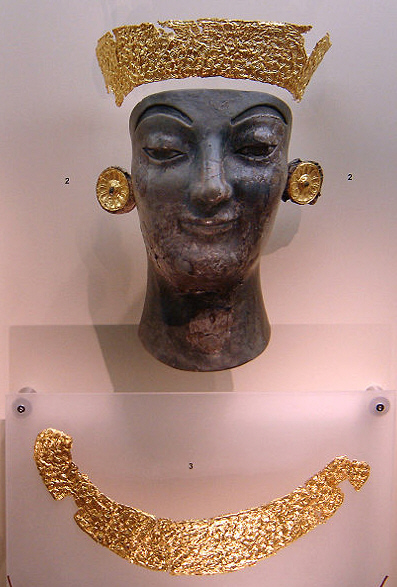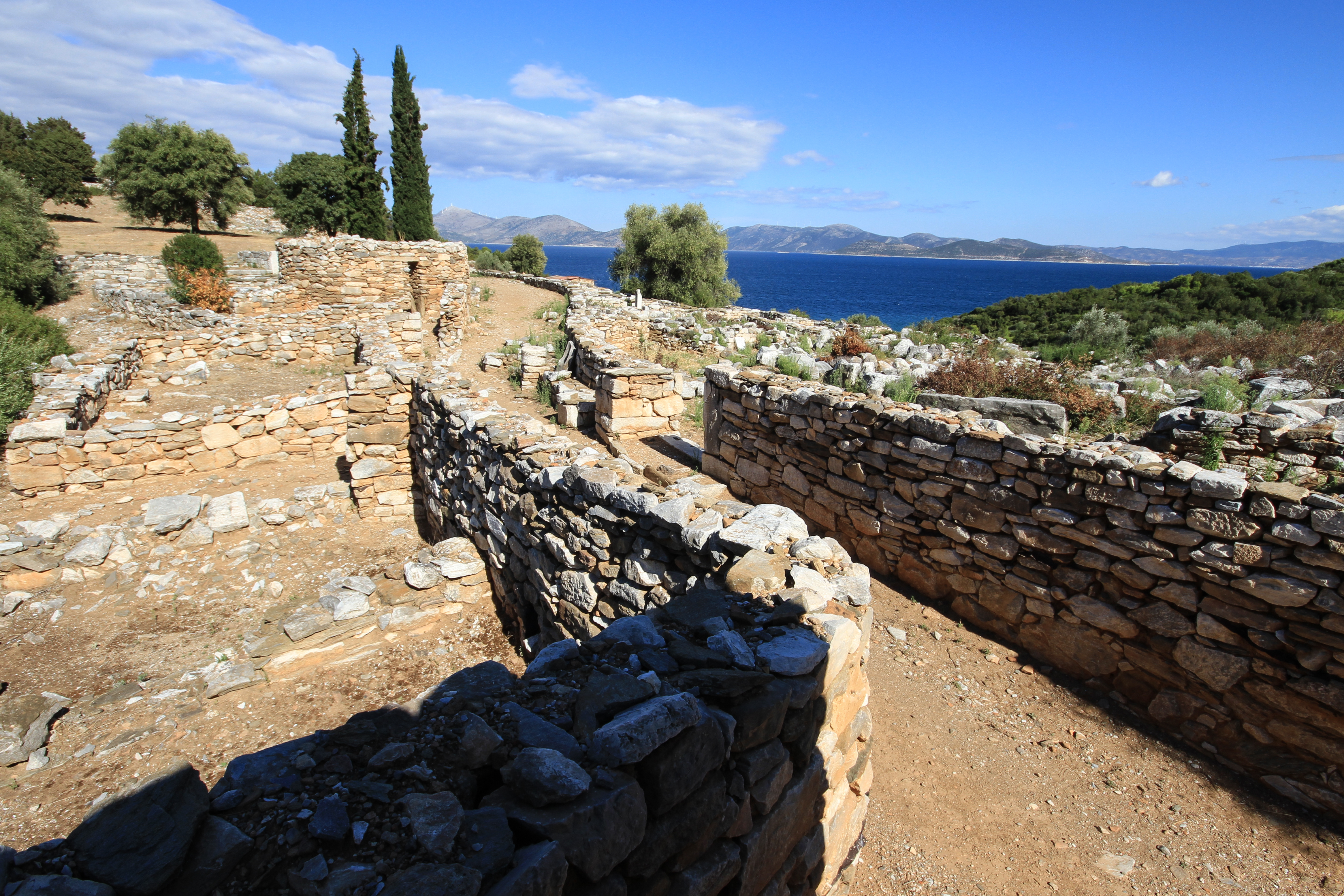|
Xoanon
A xoanon (, ; plural: , from the verb , , to carve or scrape ood was a wooden cult image from Archaic Greece. Classical Greeks associated such cult objects, whether aniconic or effigy, with the legendary Daedalus. Many such cult images were preserved into historical times, though none are known to have survived to the modern day, except as copies in stone or marble. In the 2nd century CE, Pausanias described numerous xoana in his ''Description of Greece'', notably the image of Hera in her temple at Samos. "The statue of the Samian Hera, as Aethilos The name ''Aethilos'' in the available text is thought to be a mis-spelling of ''Aethlios''. says, was a wooden beam at first, but afterwards, when Prokles was ruler, it was humanized in form". In Pausanias' travels he never mentions seeing a xoanon of a "mortal man". Types of xoana Some types of archaic xoana may be reflected in archaic marble versions, such as the pillar-like " Hera of Samos" (Louvre Museum), the flat " Her ... [...More Info...] [...Related Items...] OR: [Wikipedia] [Google] [Baidu] |
Temple Of Artemis At Ephesus
The Temple of Artemis or Artemision (; ), also known as the Temple of Diana, was a Greek temple dedicated to an ancient, localised form of the goddess Artemis (equated with the Roman goddess Diana). It was located in Ephesus (near the modern town of Selçuk in present-day Turkey). It is believed to have been ruined or destroyed by AD 401. Only foundations and fragments of the last temple remain at the site. The earliest version of the temple (a Bronze Age '' temenos'') antedated the Ionic immigration by many years. Callimachus, in his ''Hymn to Artemis'', attributed it to the Amazons. In the 7th century BC, it was destroyed by a flood. Its reconstruction, in more grandiose form, began around 550 BC, under Chersiphron, the Cretan architect, and his son Metagenes. The project was funded by Croesus of Lydia, and took 10 years to complete. This version of the temple was destroyed in 356 BC by an arsonist, commonly thought to have been a madman named Herostratus. T ... [...More Info...] [...Related Items...] OR: [Wikipedia] [Google] [Baidu] |
Erechtheum
The Erechtheion (, Latinisation of names, latinized as Erechtheum ; , ) or Temple of Athena Polias is an Classical Greece, ancient Greek Ionic order, Ionic Ancient Greek temple, temple on the north side of the Acropolis of Athens, Acropolis, Athens, which was primarily dedicated to the goddess Athena. The Ionic building, which housed the statue of Athena Polias, has in modern scholarship been called the Erechtheion (the sanctuary of Erechtheus or Poseidon) in the belief that it encompassed two buildings mentioned by the Greek-Roman geographer Pausanias (geographer), Pausanias: the Temple of Athena Polias and the Erechtheion. However, whether the Erechtheion referred to by Pausanias and other sources is indeed the Ionic temple or an entirely different building has become a point of contention in recent decades, with various scholars ruling out that Athena and Erechtheus were worshipped in a single building. Alternative suggested locations of the true Erechtheion include the structu ... [...More Info...] [...Related Items...] OR: [Wikipedia] [Google] [Baidu] |
Hera
In ancient Greek religion, Hera (; ; in Ionic Greek, Ionic and Homeric Greek) is the goddess of marriage, women, and family, and the protector of women during childbirth. In Greek mythology, she is queen of the twelve Olympians and Mount Olympus, sister and wife of Zeus, and daughter of the Titans Cronus and Rhea (mythology), Rhea. One of her defining characteristics in myth is her jealous and vengeful nature in dealing with any who offended her, especially Zeus's numerous adulterous lovers and illegitimate offspring. Her iconography usually presents her as a dignified, matronly figure, upright or enthroned, crowned with a ''polos'' or diadem, sometimes veiled as a married woman. She is the patron goddess of lawful marriage. She presides over weddings, blesses and legalises marital unions, and protects women from harm during childbirth. Her sacred animals include the Cattle, cow, cuckoo, and Peafowl, peacock. She is sometimes shown holding a pomegranate as an emblem of immort ... [...More Info...] [...Related Items...] OR: [Wikipedia] [Google] [Baidu] |
Kouros
Kouros (, , plural kouroi) is the modern term given to free-standing Ancient Greek sculpture, Ancient Greek sculptures that depict nude male youths. They first appear in the Archaic period in Greece and are prominent in Attica and Boeotia, with a less frequent presence in many other Ancient Greek territories such as Sicily. Such statues are found across the Greek-speaking world; the preponderance of these were found in sanctuaries of Apollo with more than one hundred from the sanctuary of Apollo Ptoion, Boeotia, alone. These free-standing sculptures were typically marble, but the form is also rendered in limestone, wood, bronze, ivory and terracotta. They are typically life-sized, though early Colossal statue, colossal examples are up to 3 meters tall. The female sculptural counterpart of the kouros is the kore (sculpture), kore. Etymology The Ancient Greek word kouros () refers to "youth, boy, especially of noble rank." When a pubescent was received into the body of grown men, ... [...More Info...] [...Related Items...] OR: [Wikipedia] [Google] [Baidu] |
Hera Of Delos
In ancient Greek religion, Hera (; ; in Ionic Greek, Ionic and Homeric Greek) is the goddess of marriage, women, and family, and the protector of women during childbirth. In Greek mythology, she is queen of the twelve Olympians and Mount Olympus, sister and wife of Zeus, and daughter of the Titans Cronus and Rhea (mythology), Rhea. One of her defining characteristics in myth is her jealous and vengeful nature in dealing with any who offended her, especially Zeus's numerous adulterous lovers and illegitimate offspring. Her iconography usually presents her as a dignified, matronly figure, upright or enthroned, crowned with a ''polos'' or diadem, sometimes veiled as a married woman. She is the patron goddess of lawful marriage. She presides over weddings, blesses and legalises marital unions, and protects women from harm during childbirth. Her sacred animals include the Cattle, cow, cuckoo, and Peafowl, peacock. She is sometimes shown holding a pomegranate as an emblem of immort ... [...More Info...] [...Related Items...] OR: [Wikipedia] [Google] [Baidu] |
Britomartis
Britomartis (;) was a Greek goddess of mountains, nets, and hunting who was primarily worshipped on the island of Crete. She was sometimes described as a nymph, but she was more commonly conflated or syncretized with the goddesses Artemis, Athena, and Aphaea. She is also known as Dictynna, Dicte, Dictymna, or as a daughter of Dictynna (Δίκτυννα). In the 16th century, Edmund Spenser, Edmund Spencer named a character identified with Great Britain, English military prowess as "Britomart" in his knightly Epic poetry, epic ''The Faerie Queene''. This subsequently led to a number of appearances of "Britomart" figures in British art and literature. Etymology According to Gaius Julius Solinus, Solinus, the name 'Britomartis' is from a Cretan dialect. He also says that her name means ''virgo dulcis'', or "sweet virgin". It is possible that her name also means "sweet" or "blessing" (βριτύς) "maiden," with Hesychius of Alexandria equating the Cretan βριτύ (''britý'') wit ... [...More Info...] [...Related Items...] OR: [Wikipedia] [Google] [Baidu] |
Cult Image
In the practice of religion, a cult image is a Cultural artifact, human-made object that is venerated or worshipped for the deity, Spirit (supernatural entity), spirit or Daimon, daemon that it embodies or represents. In several traditions, including the ancient religions of Ancient Egypt, Egypt, Ancient Greece, Greece and Rome, and Hinduism, cult images in a temple may undergo a daily routine of being washed, dressed, and having food left for them. Processions outside the temple on special feast days are often a feature. Religious images cover a wider range of all types of images made with a religious purpose, subject, or connection. In many contexts "cult image" specifically means the most important image in a temple, kept in an inner space, as opposed to what may be many other images decorating the temple. The term idol is an image or representation of a god used as an object of worship, while idolatry is the worship of an "idol" as though it were God. Ancient Near East and E ... [...More Info...] [...Related Items...] OR: [Wikipedia] [Google] [Baidu] |
Smilis
Smilis () was a legendary ancient Greek sculptor, the contemporary of Daedalus, whose name was associated with at the Heraion of Samos. Smilis was born on the island of Aegina Aegina (; ; ) is one of the Saronic Islands of Greece in the Saronic Gulf, from Athens. Tradition derives the name from Aegina (mythology), Aegina, the mother of the mythological hero Aeacus, who was born on the island and became its king. ....Επίτομο Γεωγραφικό Λεξικό της Ελλάδος (Geographical Dictionary of Greece), Μιχαήλ Σταματελάτος, Φωτεινή Βάμβα-Σταματελάτου, εκδ. Ερμής, ΑΘήνα 2001 References External linksAndrew Stewart, ''One Hundred Greek Sculptors: Their Careers and Extant Works''"The Sculptors: The Archaic Period" 6th-century BC Greek sculptors Ancient Aeginetans {{greece-sculptor-stub ... [...More Info...] [...Related Items...] OR: [Wikipedia] [Google] [Baidu] |
Chryselephantine
Chryselephantine sculpture () is a sculpture made with gold and ivory. Chryselephantine cult statues enjoyed high status in Ancient Greece. Ancient examples Chryselephantine statues were built around a wooden frame with thin carved slabs of ivory attached, representing the flesh, and sheets of gold leaf representing the garments, armour, hair, and other details. In some cases, glass paste, glass, and precious and semi-precious stones were used for detail such as eyes, jewellery, and weaponry. The origins of the technique are obscure. There are known examples, from the 2nd millennium BC, of composite sculptures made of ivory and gold from areas that became part of the Greek world, most famously the so-called " Palaikastro Kouros" (not to be confused with the Archaic Kouros statues), from Minoan Palaikastro, BC. It is likely the only enshrined Minoan cult image that has survived. It is, however, not clear whether the Greek chryselephantine tradition is connected with t ... [...More Info...] [...Related Items...] OR: [Wikipedia] [Google] [Baidu] |
Peplos
A peplos () is a body-length garment established as typical attire for women in ancient Greece by , during the late Archaic Greece, Archaic and Classical Greece, Classical period. It was a long, rectangular cloth with the top edge folded down about halfway, so that what was the top of the rectangle was now draped below the waist, and the bottom of the rectangle was at the ankle. One side of the peplos could be left open, or pinned or sewn together,"Ancient Greek Dress" ''Heilbronn Timeline of Art History'', Metropolitan Museum of Art, 2000–2013. Retrieved 7 October 2013. with a type of brooch later called "fibula". In Latin and in a Roman context, it could be called a ''Palla (garment), palla''. It should not be confused with the Ionians, Ionic Chiton (garment), chiton, which was a piece of fabric folded over and sewn toget ... [...More Info...] [...Related Items...] OR: [Wikipedia] [Google] [Baidu] |
Corinth
Corinth ( ; , ) is a municipality in Corinthia in Greece. The successor to the ancient Corinth, ancient city of Corinth, it is a former municipality in Corinthia, Peloponnese (region), Peloponnese, which is located in south-central Greece. Since the 2011 local government reform, it has been part of the Corinth (municipality), municipality of Corinth, of which it is the seat and a municipal unit. It is the capital of Corinthia. It was founded as Nea Korinthos (), or New Corinth, in 1858 after an earthquake destroyed the existing settlement of Corinth, which had developed in and around the site of the ancient city. History Corinth derives its name from Ancient Corinth, a city-state of antiquity. The site was occupied from before 3000 BC. Ancient Greece Historical references begin with the early 8th century BC, when ancient Corinth began to develop as a commercial center. Between the 8th and 7th centuries, the Bacchiad family ruled Corinth. Cypselus overthrew the Bacchiad f ... [...More Info...] [...Related Items...] OR: [Wikipedia] [Google] [Baidu] |
Rhamnus (Greek Archaeological Site)
Rhamnous (; ), also Ramnous or Rhamnus, was an Ancient Greece, ancient Greek city in Attica situated on the coast, overlooking the Euboea, Euboean Strait. Its ruins lie northwest of the modern town of Agia Marina in the municipality of Marathon, Greece, Marathon. The site was best known in antiquity for its sanctuary of Nemesis (mythology), Nemesis, the implacable avenging goddess, her most important in ancient Greece. Rhamnous is the best-preserved Attic deme site. It was strategically significant on the sea routes and was fortified with an Athenian garrison of ''Ephebos, ephebes'' (young men). A fortified acropolis dominates the two small harbours located on either side of it which have silted up extensively since antiquity, and into which grain was imported for Athens during the Peloponnesian War. It derived its name from Buckthorn, a thick prickly shrub, which still grows upon the site. Location Rhamnus was situated on the east coast of Attica. The town occupied a small ... [...More Info...] [...Related Items...] OR: [Wikipedia] [Google] [Baidu] |









